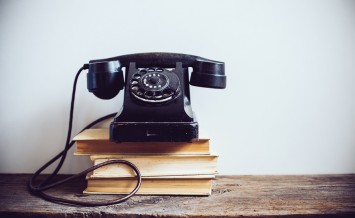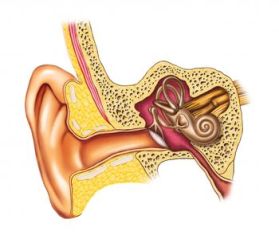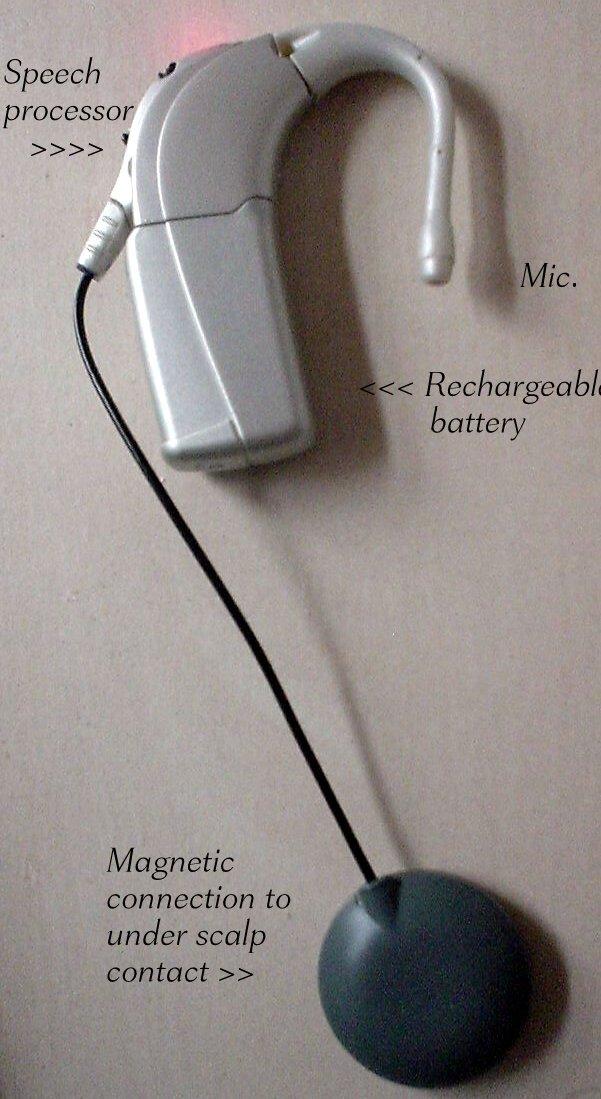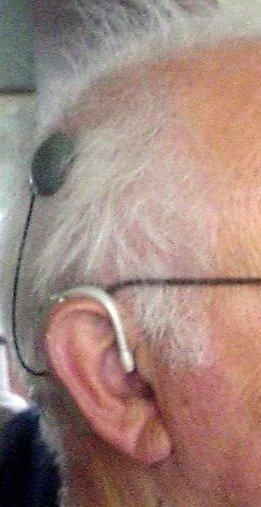Cochlear Implants – a first hand account……
This is the technology which enables many profoundly deaf people to hear again.
I had a cochlear implant in 2008.
My deafness is age related and to some extent genetic as my mother and her father were quite deaf in later life. I had noticed some difficulties as I approached the age of 60. I was issued with a hearing aid, then a digital aid, then, as things got worse I had two digital aids. But, as time went on, even these became quite ineffectual and I took to carrying around a notepad so people could write on it. Shopping became difficult, even in self service shops – not knowing what the checkout person said. … “Do want a bag?” “Any cashback?” etc…. My social life deteriorated as people found it difficult to communicate with me and I tended to be left out of conversations and would sit on the side of the group trying to look as if I was interested. So, when it was suggested that I could apply for an implant I did some research as to what it involved and managed to meet a couple of people who had had one and was impressed at how they were getting on.
In the UK the implant can be done on the NHS. There are only about 10,000 people in the UK who have a cochlear implant and many are children who were born deaf. There is a waiting list and I thought my age at the time (76) would be against me.
The whole operation, including scans, numerous tests and advisory sessions plus follow up costs at least £30,000. Your level of hearing in both ears is assessed, a check is made as to where the problem lies; some people are not suitable. Although the tiny hairs in the cochlea may have atrophied over time or have been damaged by loud noise, that does not matter. There is a CT scan to look at your cranium and the cochlear structure; and tests as to your level of balance. Obviously, you will only be considered suitable if your problem cannot be alleviated by hearing aids. And, as the operation includes carving out a place in the surface of the skull to fit a small part of the electronics (under the scalp behind the ear) and also inserting an electronic probe down through the skull and into the cochlear itself, they have to make sure that this is possible in each case. The surgeon has to avoid your facial nerve and your jugular vein. Hitting the one would make you rather ugly, the other would be curtains! There is a slightly increased risk of meningitis, so one is vaccinated against this. If they agree to go ahead and fit one you will then have to attend regular sessions for a couple of months followed by up to a year of occasional sessions to adjust the device and also to help you adjust to the new sounds that you receive. To some extent your brain has to interpret these. Although you hear much more, the sounds are not completely natural. Higher frequency sounds predominate and it is not suitable for most music. But for someone who has got to the end of the line when it comes to hearing aids, or who was born deaf, it is a considerable improvement. Certainly the people I talked to who had one, were encouraging and were able to carry on normal conversations. The equipment consists a behind the ear speech processor, similar to a slightly larger hearing aid, with a rechargeable battery attached. I have four interchangeable batteries, one being recharged every night. Plus a microphone hook. The connection, under the scalp is connected to the processor via a round magnetised connector and thin cable. The under scalp connector is attached to a dozen electrodes which go into to the cochlear at various depths Although my device is plain to see, unless I wear a hat, for people with more hair it would hardly be noticeable and might be mistaken for some music gadget or Bluteooth phone.
The operation is done under general anaesthetic and takes up to three hours. One is warned that you might have slight pain from the surgery and the likelihood of balance problems due to the leakage of fluids which are contained in the cochlea and what I call the gyroscopes. The two are connected. The fluid is what causes you to feel giddy if you play that game where someone turns you round quickly.
I did not feel too bad when I woke up. I spent the night in hospital with a dressing over the wound on my scalp and was allowed to return home the following day after a visit from the surgeon. At the hospital I felt decidedly ‘light headed’ and he asked me to walk to the room door and back, which I managed to do without having to hang onto anything. I was not allowed to drive but returned home feeling that everything had gone very well.
After a couple of days my balance deteriorated and I found myself needing to hang onto the banister going downstairs and feeling for a wall here and there, although I could walk without aid if I concentrated. I even found I could ride a bicycle. One night I was woken by dizziness three times in succession and was sick; a VERY unpleasant feeling. I did not expect this and was really concerned, thinking I would never again be able to sleep without the worry that I would wake up dizzy. I decided to prop myself up in bed for the rest of the night and the dizziness has not recurred. For a short while I continued to get occasional head and ear aches but had been given Ibuprofen and Paracetamol tablets in case I was uncomfortable. After a couple of days I was surprised to have a loss of sensation on the side of the tongue and a loss of taste. The hospital was consulted and I was assured that it was a side effect and that it was early days. The taste buds revived after a few days and I became less unbalanced after about three weeks. I felt that this was more a question of my brain being accustomed to the new situation than any repair of the balance mechanism. At the next checkup everything appeared satisfactory. I found that my driving was not affected, even during the period when my balance was disturbed, so went back to driving about ten days after the operation. I was given a list of appointments and was disappointed to see that my next one, for the speech processor and ‘switch on’ was TWO MONTHS after my operation. As I was struggling on with one feeble hearing aid (the hearing having been destroyed in my implanted ear), things became MORE difficult and I had to ask people to write things down all the time. It was unfortunate that the operation had to be performed on my better ear. But there was a complication with the left ear, the area being too close to my left jugular. One doesn’t argue with surgeons about such matters!
At last the big day arrived and I had to attend the hospital for most of the afternoon. After an explanation as to what I might expect, the speech processor was fitted behind my ear and the magnetic connection placed on my head. Then began a lengthy computer-based setting up process, when I was able to hear tones and was told to respond to these for lowest and highest acceptable volumes. This is done for each of the 12 electrodes which were now deep in my cochlear. At last, after the program was installed in the speech processor it was finally turned on and I was able to hear the nurse speaking without the aid of a traditional hearing aid. The voice was a little distant and ‘thin’ and fairly high but right from the start I was able to make out what she was saying and passed a simple test with and without lip reading. As had been explained before, it takes time for the brain to adjust to speech. But other sounds, from the rustling of paper, to the flushing of a loo were extremely clear. This keyboard is now making a great deal of noise, which it never did before and the blackbirds are singing sweetly outside! So, things were at least up to expectations and maybe a little better. It is a relief to feel that, instead a gradually worsening situation my hearing will not deteriorate further.
After a second adjustment session I had a word recognition test. I achieved 86%, which is a great deal more than when I took the same test with two digital aids. (I was then only able to correctly distinguish 50% ). I am now able to hold conversations with people, which I was unable to do without a great deal of effort (and embarrassment) while wearing hearing aids. My confidence to do things like order drinks and go shopping has improved enormously.
During the first year I attended monthly training and adjustment sessions. The speech processor is adjusted using a computer and the patterns matched to my hearing based on which high and low sounds I said were the clearest. The gadget can contain three programs for different situations, one of which is for use with loop devices. However, I tend to stick to just one program, although I do adjust the amplification from time to time.
I would say that my hearing is now back to about 80% of normal but much depends on the situation I am in. As with hearing aids the best situation is a quiet room (or outdoors) with no other chatter going on. The echo one receives in a room with hard surfaces makes it MUCH more difficult. It is difficult to say which voices suit the implant best. Men’s and women’s voices are equally easy to understand in the right circumstance, though they tend to sound a little higher. I have been able to hold chats with several people using Skype, using a PC. I use the speakers and a small webcam with an internal microphone. With Skype, one does get something out of the video and people can always type the odd word if I have find any difficulty.
I try to avoid using the telephone, especially with people who are not aware of the problems. I find that telephone quality is lower than a PC speaker, so talking to someone in Australia with Skype can be easier than talking to someone on the phone down the road.
The speech processor is just that. It doesn’t make a lot of sense out of music, so anyone expecting that would be disappointed. And, although I hear quite a lot of what is said on TV I still tend to turn on subtitles for items I think are important.
After the regular checkups during the first year I now attend annually unless I request an additional check.
Summing up… I would hate to be without my implant. If I take it off, I can now just about hear noise with my left ear, so am profoundly deaf.. The last test (random sentences spoken by a face on a screen) showed that my hearing was as follows:
With the implant I got 98% correct in a quiet situation (up from 86% when the implant was first fitted) and 82% with simulated noise.
With a digital hearing aid in the left ear I had got 11% correct. With the aid in the right ear I got 34% right. With both aids I got 50% right.
Need I say more?
Written by: Keith Paterson August 2012
Latest posts by SuffolkSilver (see all)
- iPad … My view! - September 1, 2015
- Scam alert! - April 29, 2014
- Ten tips from the Suffolk Silver Surfer - January 10, 2014
- Granchester - August 6, 2013
- Whither Microsoft? - January 31, 2013























